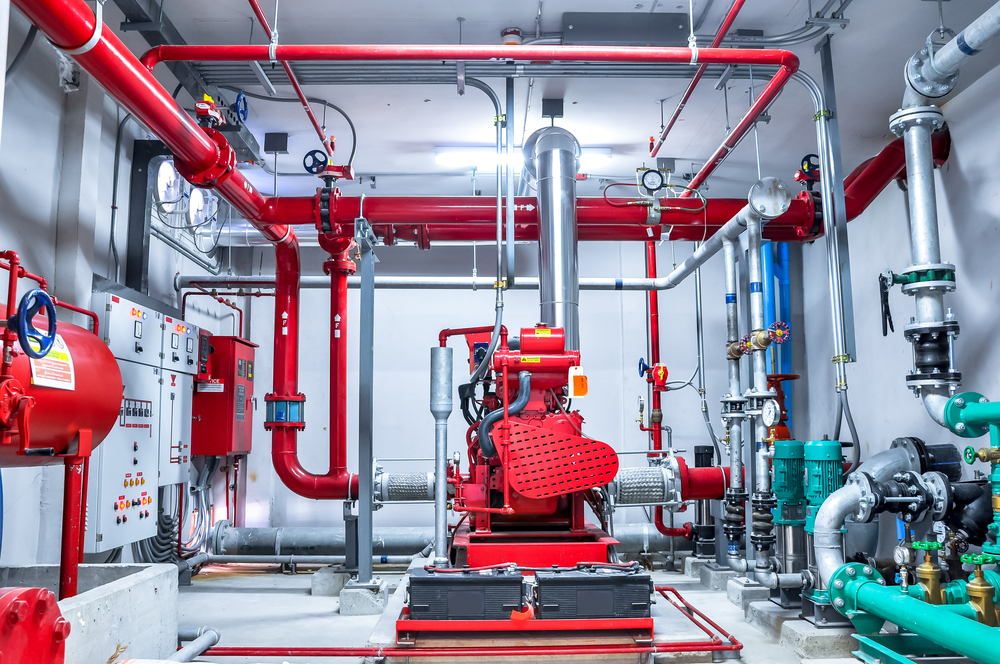Fire pumps are an essential part of modern fire protection systems, especially when the water supply does not have enough capacity to power sprinklers or standpipes. These pumps increase the force and flow of water, ensuring that in the event of a fire there is enough water to reach every part of the building. Whether you are in an apartment building or a large warehouse, fire pumps are essential for controlling or extinguishing a fire before it causes significant damage or loss of life.
The Importance of Fire Pumps in Building Design
Today, many commercial and residential buildings have complex layouts, many floors, and large floor areas. In these locations, gravity or municipal water supply may not be sufficient. Fire pumps fill this gap by increasing the flow of water to the proper amount for fire suppression. This is especially important in high-rise buildings, where water pressure must be reduced through pipes that flow up and down. Without fire escapes, the upper floors of these buildings can be open in the event of a fire, exposing the people inside and rescuers to great danger.
Fire Pumps in Commercial Buildings
In most cases, commercial buildings require more fire protection than residential buildings because they contain more flammable materials, more people, and more equipment. In these buildings, fire pumps are often part of a larger fire protection system that also includes sprinkler systems, fire hoses, and alarm systems. In shopping malls, factories, and office buildings, for example, fire pumps ensure that sprinklers receive water at the right pressure to extinguish fires quickly and effectively. This prevents excessive damage to property and equipment and helps businesses get back to work faster after a fire.
Where to Get a Fire Pump in Your Home
Fire pumps are just as important in residential buildings, especially in multi-unit buildings such as apartment complexes and condominiums. They ensure that all units receive the same amount of water, regardless of how far apart or at what elevation they are. For rural homes that rely on well water or do not have easy access to running water, a fire pump connected to a water tank can effectively prevent fires from breaking out before they become a disaster. These systems can be customized to fit the size and shape of the building while providing strong fire protection.
How a Fire Pump Works
In most cases, fire pumps are activated either manually or automatically when the fire alarm sounds or the pressure in the fire system drops below a certain level. Once activated, a fire pump draws water from a stable source, such as a tank, reservoir, or mains water system, increases the pressure, and then pumps the water into the system. Centrifugal pumps, vertical turbine pumps, and positive displacement pumps are different types of fire pumps. Each type of fire pump is suited for different purposes, depending on the shape of the building and the method of water delivery. Regardless of the type, the primary role is to ensure a consistent flow of water where and when it is most needed.
Why Proper Installation is So Important
Fire pump installation involves more than just putting it in the engine room and connecting it to the pipes. It requires careful planning and adherence to national fire safety rules and regulations, such as those of the National Fire Protection Association (NFPA). These rules cover everything you need to know about fire pumps, including the types of pumps, the pressures they can withstand, and how to test them. When building and installing a fire pump system, it is important to consult with an experienced fire protection expert or contractor, because if this is not done properly, the entire fire protection system will not function properly.
Testing and Regular Maintenance
Without regular maintenance, even the most advanced fire pumps are rendered useless. Wear, rust, or blockages will reduce the performance of the system over time. A regular maintenance schedule should include weekly inspections, monthly agitation tests, and annual flow tests to ensure that the system remains in top condition. Owners and building managers should also keep accurate maintenance logs to comply with safety regulations and insurance requirements. If you do not properly maintain your fire pump, it can fail over time, putting people and property at risk.
Compliance and Insurance Considerations
Owning a fire pump system can also affect your insurance premiums and compliance, and this is true for both businesses and homes. Many insurance companies are reducing premiums for role risk.
Fire pumps and emergency services
Regular firefighters often use a building’s fire pump system to extinguish fires. When the fire pump is working properly, the hydrants, standpipes, and sprinkler systems are operating at full capacity. This makes it easier for emergency responders to do their jobs. In large commercial buildings, the operation of the fire pump is crucial to extinguishing the fire or destroying the entire building. Well-maintained fire pumps are part of the building’s overall safety plan and are essential in high-pressure situations.
Future developments in fire pump technology
Technological changes are also influencing the future of fire pump systems. Remotely monitored smart fire pumps can now transmit real-time status updates to emergency services or building managers. These systems can inform people before problems become serious, speeding up maintenance and response times. Additionally, researchers are developing pumps that use less energy, reducing the environmental impact of fire protection systems without compromising safety. As cities continue to grow, especially in high-rise and mixed-use buildings, the demand for smart and fast fire pumping systems will increase.
Summary
Fire pumps are an important part of fire safety systems for both commercial and residential buildings. They ensure that water flows at a moderate pressure to every corner of the building to effectively extinguish fires. They do more than just provide water; they help keep people safe, protect property, meet fire regulations, and save insurance costs. When properly installed, regularly maintained, and incorporated into a building’s overall safety plan, fire pumps provide peace of mind and ensure that people are prepared to respond to fires. Whether protecting a small apartment building or a large commercial complex, fire pumps are always there, quietly protecting one of nature’s most destructive threats.

